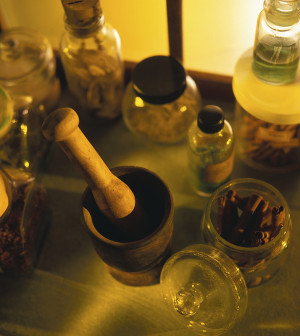- Skip Storing This Everyday Product in the Fridge Door
- Green Tea + B3 Pairing May Boost Brain Health
- Navigating Your Midlife Crisis: Embracing New Possibilities
- City Raccoons Showing Signs of Domestication
- Mapping the Exposome: Science Broadens Focus to Environmental Disease Triggers
- One Week Less on Social Media Linked to Better Mental Health
- Your Brain Changes in Stages as You Age, Study Finds
- Some Suicide Victims Show No Typical Warning Signs, Study Finds
- ByHeart Formula Faces Lawsuits After Babies Sickened With Botulism
- Switch to Vegan Diet Could Cut Your Greenhouse Gas Emissions in Half
Alternative Therapies Widely Used for Autism


Nearly 40 percent of preschoolers with autism are getting some kind of complementary or alternative therapy for their condition, with nutritional supplements and special diets being the most common things parents try, a new study shows.
There are no medications currently approved specifically to treat autism spectrum disorders and its core symptoms of social and behavioral problems, according to the U.S. Centers for Disease Control and Prevention. Autism symptoms also include stomach upset and difficulty sleeping, among others.
So doctors and parents often rely on a variety of different, and sometimes unproven and unconventional, treatments to try to manage the wide variety of issues that can crop up.
Some experts had feared that parents might be turning to complementary therapies because they couldn’t access recommended social or behavioral services or because they were trying to avoid conventional medicines, like vaccines.
But the study, published in the January issue of Journal of Developmental and Behavioral Pediatrics, found that wasn’t the case.
Children in the study were 2 to 5 years old. Nearly all of the 453 children who had autism and another 125 with developmental disabilities were receiving the kinds of physical or behavioral therapy and other kinds of social services that are typically advised to help manage the condition. Many were also taking some kind of conventional medication for symptoms like acid reflux, constipation or mood disorders.
Yet, children getting more than 20 hours of traditional behavioral and educational services a week were more likely than others to also be receiving alternative treatments.
“So it wasn’t because they couldn’t get access to services. It was just the opposite: The more services you got, the more likely you were to be getting complementary medicine,” said study author Dr. Robin Hansen, chief of child development and behavioral pediatrics at the University of California, Davis.
Hansen said the severity of the condition didn’t appear to be a factor in the decision to try an alternative treatment. And children with autism were just as likely to be fully vaccinated as their normally developing peers.
But education did seem to play a role. Children with at least one parent who had finished college were about twice as likely to be using a complementary therapy as kids with less-educated parents.
The most common complementary treatments reported by parents were considered to be relatively safe. Those included dietary supplements and special diets. Nearly one in four parents reported turning to specialized nutritional products (multivitamins and gummies weren’t counted). And almost one in five kids in the study was on a gluten-free, casein-free diet, which cuts out the proteins found in wheat and milk.
About 9 percent of children in the study were using therapies that were unproven, invasive or potentially unsafe. Those included the use of antifungal drugs to treat yeast infections, vitamin B-12 injections and chelation (a controversial treatment used to remove metals from the body).
“These complementary and alternative treatments are occurring much more commonly than traditional doctors often think,” said Dr. Eric Hollander, a psychiatrist at the Albert Einstein College of Medicine and Montefiore Medical Center, in New York City.
Hollander said it was important for parents to let their doctors know if they decide to try any kind of complementary treatment.
“I’ve had patients who’ve had benefits from various complementary approaches, but I’ve had patients who’ve had side effects as well,” said Hollander, who treats children with autism.
“As a clinician, I like to keep an open mind, and I’m interested in what parents are reading or thinking about. And I want them to be able to approach it in a systematic fashion, where they give it a limited trial and see if there’s any benefit,” he said.
The problem many families face, he said, is that they try too many things at the same time. Then it’s hard to figure out what’s working and what isn’t.
“The key is to have a good working relationship with your doctor so you can sort out the benefits and risks,” he said.
More information
For more about complementary and alternative treatments for autism, visit Autism Speaks.
Source: HealthDay
Copyright © 2025 HealthDay. All rights reserved.










